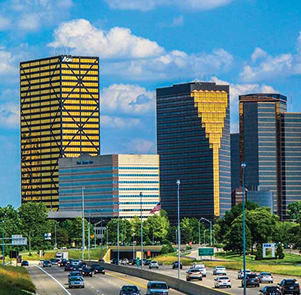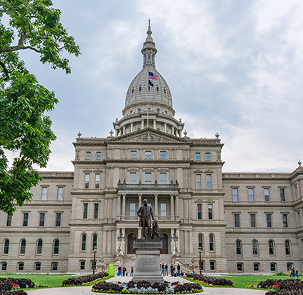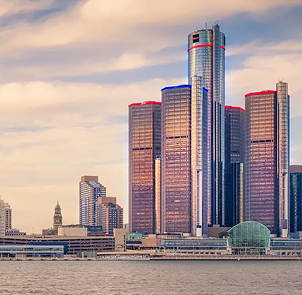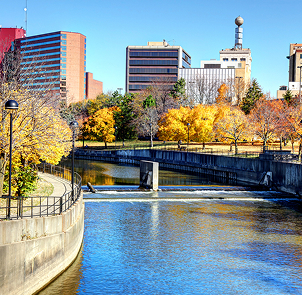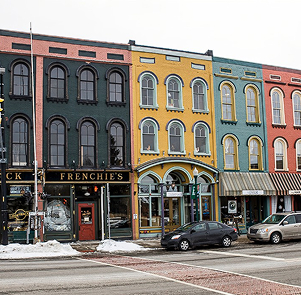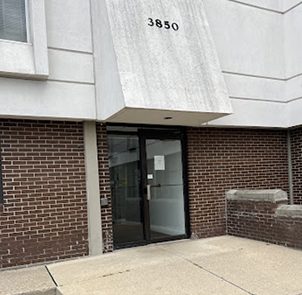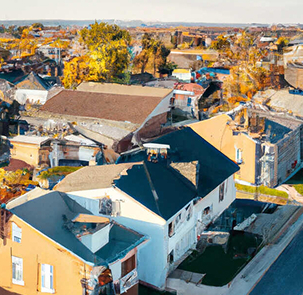Who Is At Fault For Deer-Car Collisions?
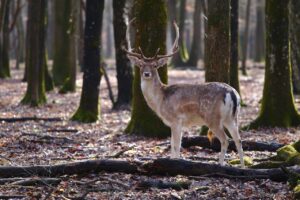
When a deer suddenly appears on the road, the instinctive reaction might be to swerve. However, this can lead to more severe accidents, such as colliding with oncoming traffic or hitting trees and other roadside objects. Instead of swerving, drivers should focus on safe braking.
When a motorist hits a domesticated animal or livestock that wanders into the road, there is clear liability for the owner who is negligent in allowing the animal to be loose. If you hit a wild animal such as a deer, however, it is not immediately apparent where the fault lies.
The Michigan State Police reports that around 50,000 vehicle-deer crashes occur in the state every year. In the event that you find yourself in this unfortunately common scenario, it is important to understand the matter of fault and what your options are for covering the costs of damages you sustain to yourself or your property.
Furthermore, certain states consistently experience high rates of fatal deer collisions. In the Midwest region, states such as Wisconsin, Minnesota, Illinois, Iowa, Michigan, and Ohio frequently rank among the most affected. These areas see a significant number of encounters on roads, leading to serious accidents. The prevalence of deer populations combined with expansive rural areas increases the likelihood of these incidents.
When traveling through these states, it’s crucial to stay vigilant, especially during peak deer activity seasons, to reduce the risk of collision.
Are You Liable for Hitting a Deer With Your Car?
No legal liability exists in instances when a motorist hits a wild animal. This means that you are not liable for the accident and will face no penalties or fines when you hit a deer with your car.
However, this also means that neither the state nor anyone else is at-fault for the collision either. There is little to no opportunity for you to pursue damages through a personal injury claim. If you incur repair costs as a result of your deer-car collision, your best option for covering the expenses is through your insurance policy.
Does Insurance Cover Deer Collisions?
Each year, deer-related accidents lead to substantial financial repercussions. These incidents account for vehicle damage exceeding $1 billion annually.
If your insurance policy includes comprehensive coverage, then you can receive a settlement for incidents that are out of your control. This includes situations in which you hit a deer with your car as well as the opposite circumstance when a deer is the one hitting your property.
Keep in mind that the terms of your policy do not consider damages to be “out of your control” if you are responsible for swerving your vehicle to avoid a deer and therefore hitting another car or object. In these instances, you need collision coverage on your plan to cover any repair costs.
In addition to navigating the complexities of which coverage applies to your accident, there are a few other insurance-related considerations to keep in mind after a deer-car collision.
Does Insurance Cover Injuries From Deer Collisions?
Your auto insurance policy might contain comprehensive or collision coverage that provides compensation when a deer causes damage to your vehicle, but these options do not cover any bodily injuries you sustain. If you have a health insurance policy that includes medical payments coverage or personal injury protection, you might be able to receive assistance in paying for your medical bills.
Do You Have To Pay a Deductible After a Deer-Car Collision?
The terms of your comprehensive auto coverage likely include a deductible that you must pay when filing a claim for damages before insurance kicks in. Deductible amounts typically start at $100 or more, but your insurer will cover the remaining expenses if your claim is valid.
Will Hitting a Deer Make Your Insurance Rates Go Up?
Most insurance providers consider deer-car collisions to be random events that drivers cannot control, meaning that your insurer is not likely to pin the fault on you for the accident. It is important to contact your insurance company for verification, but most instances of hitting a deer will not lead to higher insurance rates.
What Should You Do After Hitting a Deer?
Hitting a deer is a surprising or even panic-inducing event, but it is important to try to remain calm and take the appropriate actions afterward. Your first priority is to move your vehicle off the road and to keep a safe distance from the animal. You cannot know for sure if the deer is dead, but if it is alive, it is likely frightened and therefore highly dangerous.
After confirming your own safety, the next step is to call 911 and report that an animal is blocking the road. Proper removal of a stunned or deceased animal is a job for trained authorities. Keep in mind that it can be a good idea to contact the police and report any damages even if the deer runs away after the collision.
You should then take the time to fully document the accident and collect evidence that might be useful when filing a claim. Photograph the site of the collision as well as the damage to your vehicle and any injuries sustained by you or your passengers. It can also be prudent to exchange contact information with any witnesses or other motorists who stop to provide assistance.
Get off to a strong start on the claims process by contacting your insurance company while the incident is still fresh in your mind. Be careful about making any agreements or accepting any settlements too quickly, though. Consider involving your lawyer early on in the process to help you get a fair payout for your damages.
Make sure your vehicle is safe to drive before leaving the scene. If an impact from a deer affects sensitive parts of your car that are critical for driving, it may be necessary to contact a towing service. An insurance plan which includes roadside assistance coverage can help you pay for this type of expense.
How Can You Avoid Hitting a Deer?
Being proactive about learning how to avoid a deer-car collision can help you avoid an accident that might cause significant damage to your vehicle or even result in injury to yourself. Always exercise caution when you see a road sign indicating that a stretch of road is a common crossing place for deer. Bear in mind also that deer frequently travel in groups, so it is possible that multiple deer might enter the road if you spot one.
- Reduce Speed Safely: First, gently apply the brakes to slow down as much as possible. Avoid slamming on the brakes to maintain better control of the vehicle.
- Stay in Your Lane: It’s crucial to keep the vehicle straight and within its lane. Swerving can lead to a loss of control or a more serious collision.
- Brace for Impact if Necessary: Sometimes, hitting the deer may be unavoidable. By keeping your car straight, you’re minimizing potential damage and enhancing safety for yourself and your passengers.
Why Not to Swerve:
- Increased Risk: Swerving can lead to hitting another vehicle, rolling over, or crashing into stationary objects, increasing the risk of severe injuries.
- Unpredictable Outcomes: Wild maneuvers may cause more harm than a direct impact with the deer.
While it goes against natural impulses, maintaining control by not swerving ensures the safety of everyone involved. Remember, the key is to act calmly and purposefully to minimize risk.
Enhancing Nighttime Visibility to Avoid Deer Collisions
Driving at night poses unique challenges, and wildlife like deer can suddenly appear, creating potentially dangerous situations. High beams are a crucial tool for improving your nighttime visibility and can significantly reduce the risk of deer-related accidents.
Why Use High Beams?
- Extended Visibility: High beams cast a broader and further-reaching light path, illuminating not just the road ahead but also the areas flanking your route. This increased visibility helps spot deer, which may linger near road edges or suddenly dart into oncoming traffic.
- Early Detection: By spotting deer from a greater distance, you gain valuable reaction time, allowing you to slow down or stop more safely and avoid a collision.
When to Switch On Your High Beams
- Use When Oncoming Traffic Is Absent: Ensure that no oncoming vehicles are nearby, as high beams can impair the vision of other drivers, leading to potential hazards.
- Switch Off for Approaching Vehicles: If you spot another car, dim your lights to prevent dazzling the driver.
By strategically using high beams, your nighttime drives can be not only safer but also less stressful, knowing you have maximized your ability to see potential hazards in time to react effectively.
When Are Deer Most Active, and When Should Drivers Be Extra Cautious?
Deer are creatures of twilight, often referred to as crepuscular. This means they are most active during the periods around dawn and dusk. These transitional times of the day provide them with enough cover to forage while avoiding predators. Key times of day are dusk and dawn. Although deer can roam throughout the entire day, their activity peaks at dawn and particularly at dusk. From 6 PM to 9 PM, expect increased movement, especially as deer start to search for food after the sun sets.
What Happens if Hitting a Deer Causes a Multi-Car Accident?
Deer-car collisions are not just a concern for your vehicle; they can have serious and sometimes fatal consequences. Consider the alarming statistics:
- There are approximately 1.5 million deer-related car accidents annually.
- These accidents result in over $1 billion in vehicle damage each year.
- Annually, around 175-200 fatalities occur due to these collisions, with 10,000 injuries reported.
Circumstances regarding fault and liability may differ when a driver swerves in response to seeing a deer on the road and causes a multi-car accident as a result. In such an event, the driver who swerves or loses control of their vehicle is likely responsible for any property damage or injuries in the eyes of the law. In any multi-car accident, it is important to exchange insurance information with all drivers involved and to seek legal representation to protect your interests, regardless of your role in the collision.
What Can a Lawyer Do for You After a Deer-Car Collision?
Working with a car accident lawyer can help ensure that you get the financial assistance you need after a devastating deer-car collision. Your legal team can help you interpret your insurance policy to determine whether your plan covers the damages and how much compensation you truly deserve. If your insurer offers a lowball settlement, an attorney can negotiate and advocate on your behalf or even represent your interests in court if necessary.
Having a lawyer on your side is particularly important if a wildlife-related accident results in a multi-car collision. Filing a personal injury claim against another driver can be complex, but an attorney with experience in car accident cases can help you navigate your options even when an at-fault motorist lacks proper insurance.
Your Solution for Overcoming the Aftermath of a Deer-Car Collision
There is no fault in a straightforward deer-car collision or most other accidents involving a wild animal, but that does not mean that putting the matter to rest is simple. You need someone in your corner who will help you get what you deserve from the insurance company in line with the terms of your policy. Contact the Mike Morse Law Firm online or give us a call at 855-MIKE-WINS (855-645-3946) and we will help you take the next steps.
